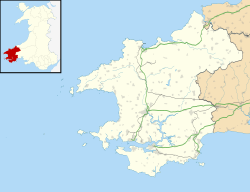RAF Angle
| RAF Angle HMS Goldcrest |
|||||||||||
|---|---|---|---|---|---|---|---|---|---|---|---|
| Near Angle, Pembrokeshire in Wales | |||||||||||
|
Shown within Pembrokeshire
|
|||||||||||
| Coordinates | 51°40′28″N 005°05′54″W / 51.67444°N 5.09833°WCoordinates: 51°40′28″N 005°05′54″W / 51.67444°N 5.09833°W | ||||||||||
| Type | Royal Air Force station | ||||||||||
| Site information | |||||||||||
| Owner | Air Ministry | ||||||||||
| Operator | Royal Air Force | ||||||||||
| Site history | |||||||||||
| Built | 1941 | ||||||||||
| In use | 1941-1950 | ||||||||||
| Airfield information | |||||||||||
| Elevation | 63 metres (207 ft) AMSL | ||||||||||
|
|||||||||||
Royal Air Force Angle or more simply RAF Angle is a former Royal Air Force station located 3.9 miles (6.3 km) south east of Dale, Pembrokeshire and 8.1 miles (13.0 km) west of Pembroke, Pembrokeshire, Wales.
It was opened on 1 December 1941 and closed in the 1950s after being used by both the Royal Air Force (RAF) and the Royal Navy.
It was initially used by No. 32 Squadron RAF flying the Hawker Hurricane I. In November 1941 they were replaced by 615 Squadron, and the Hurricane IIC. Several Squadrons followed: 312 Squadron flew the Supermarine Spitfire VB and 263 Squadron with the Westland Whirlwind.
Next No. 152 Squadron RAF, No. 412 Squadron RCAF and No. 421 Squadron RCAF squadrons occupied the base, flying the Spitfire VB.
During May 1943 794 Naval Air Squadron were posted here conducting target towing and the control of the airfield was transferred to the Royal Navy with the site being renamed RNAS Angle (HMS Goldcrest). However in September 1943 the Royal Navy moved from RNAS Angle to the RNAS Dale, and the RAF swapped sites in the other direction with the Coastal Command Development Unit moving in.
The airfield was used as the base for trials of the prototype Highball bouncing bomb on 6 October 1943 using a tunnel at Maenclochog as a target. Highball was a spherical design with dimples by Barnes Wallis and were dropped by de Havilland Mosquito aircraft.
...
Wikipedia

